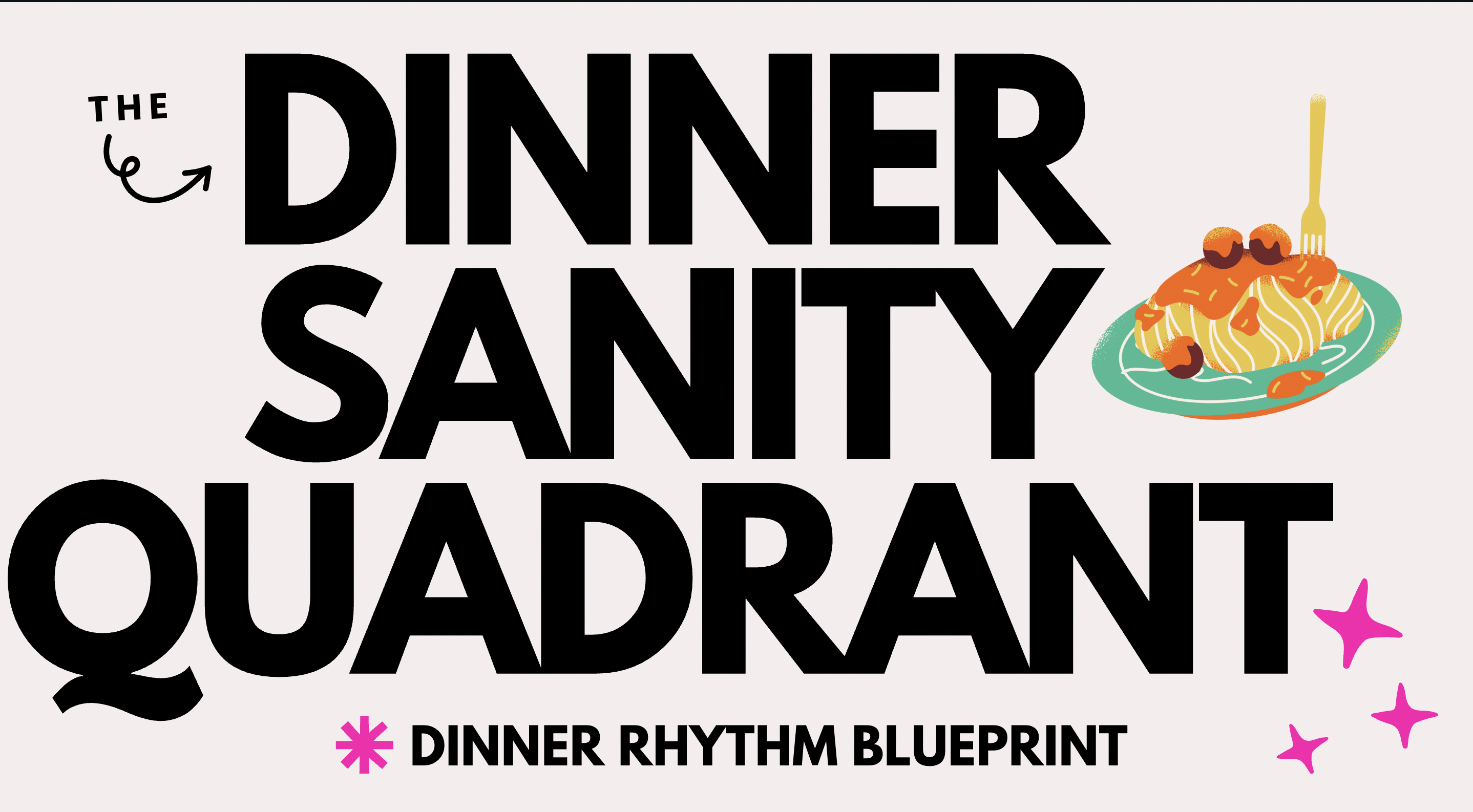
👉 This post is Part 3 of the Dinner Rhythm Blueprint series. If you're just joining us, I highly recommend starting from the beginning so everything clicks in order. You can catch up on Part 1: Dinner Rhythm Overview and Part 2: What's Left in the Tank Test, or head straight to the Dinner Rhythm Blueprint Hub for the full series.
Dinner can feel complicated-but it doesn't have to be. In this step, we're going to use a tool called the Dinner Sanity Quadrant to help you sort your meals based on effort and enjoyment. This is how you start building a rhythm that matches both your energy and your family's real-life preferences.
VIDEO LESSON #3: The Dinner Sanity Quadrant 👇👇
This is where things start to click. In this quick video, I'll walk you through the Dinner Sanity Quadrant-a simple framework for sorting your meals based on ease and enjoyment. You'll finally see why some dinners always work, and others always feel like a fight.
👉 Watch the video or listen while you fold laundry. This is the step that helps you build a rhythm you can actually stick to
Press play to watch now 👇👇
Grab Your Free Dinner Rhythm Workbook 👇👇
To make this process even easier, I created a free Dinner Rhythm Workbook you can print and use alongside this series. You'll find simple worksheets for each lesson-so you're not just reading, you're actually mapping out your rhythm in real time.
Hey friend-welcome back to the series.
This is where things really start to come together. We're going to lay the foundation for your personal Dinner Rhythm Blueprint by asking a few really important questions.
These aren't about what you wish you were cooking… they're about what's actually happening in your kitchen right now.
We're not planning anything new just yet. We're just getting honest.
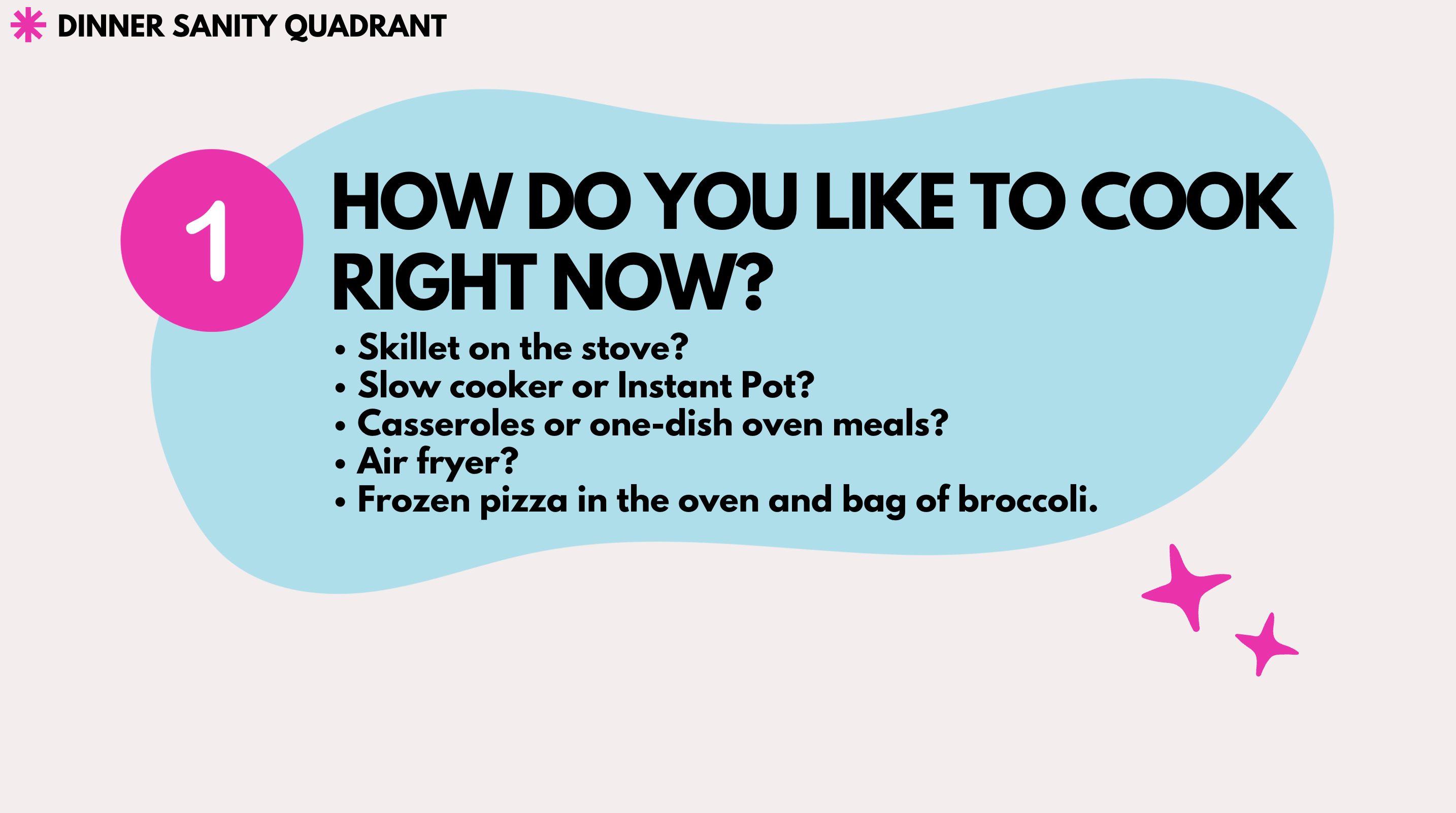
Step 1 - How Do You Like to Cook Right Now?
Let's start with the cooking methods you naturally gravitate toward.
- Do you usually cook dinner in a skillet on the stove? 🍳
- Do you love your slow cooker or Instant Pot?
- Do you lean on casseroles or one-dish oven meals?
- Are you best friends with your air fryer?
- Or maybe you toss a frozen pizza in the oven and steam a bag of broccoli.
👉 There is no "right" answer here. The goal is simply to notice your default style.
When you know how you already like to cook, you can stop forcing methods that don't fit your life. (Need ideas for streamlining? Try these quick dinner shortcuts.)
Pause here and jot down the cooking tools + methods you actually use on a random Tuesday night. Not what you want to do someday. Not what your neighbor does. Just you.

Step 2 - What Do You Already Make?
Now, let's talk about the actual meals showing up on your dinner table most often.
These don't need to be fancy. They don't even have to be recipes.
Here's an example from my own house:
- Shake 'n Bake chicken thighs
- Rice in the rice cooker
- Kale salad (that-miraculously-my daughter eats without protest 🥬)
Is it a gourmet recipe? Nope. Is it dinner? Absolutely.
Maybe your go-to is Kraft Dinner. Or eggs and toast. Or frozen pizza. Or cereal with a side of "I just couldn't deal today."
👉 There is zero shame here. We're not here to judge-we're here to take stock. Think of this like a dinner diary. Just tell the truth about what's really happening at 5:30 p.m.
Pause here and make that list of as many dinners you cook regularly as you can.
(Need easy wins for low-energy nights? Try these 10 dinner ideas for when you're too tired to cook.)
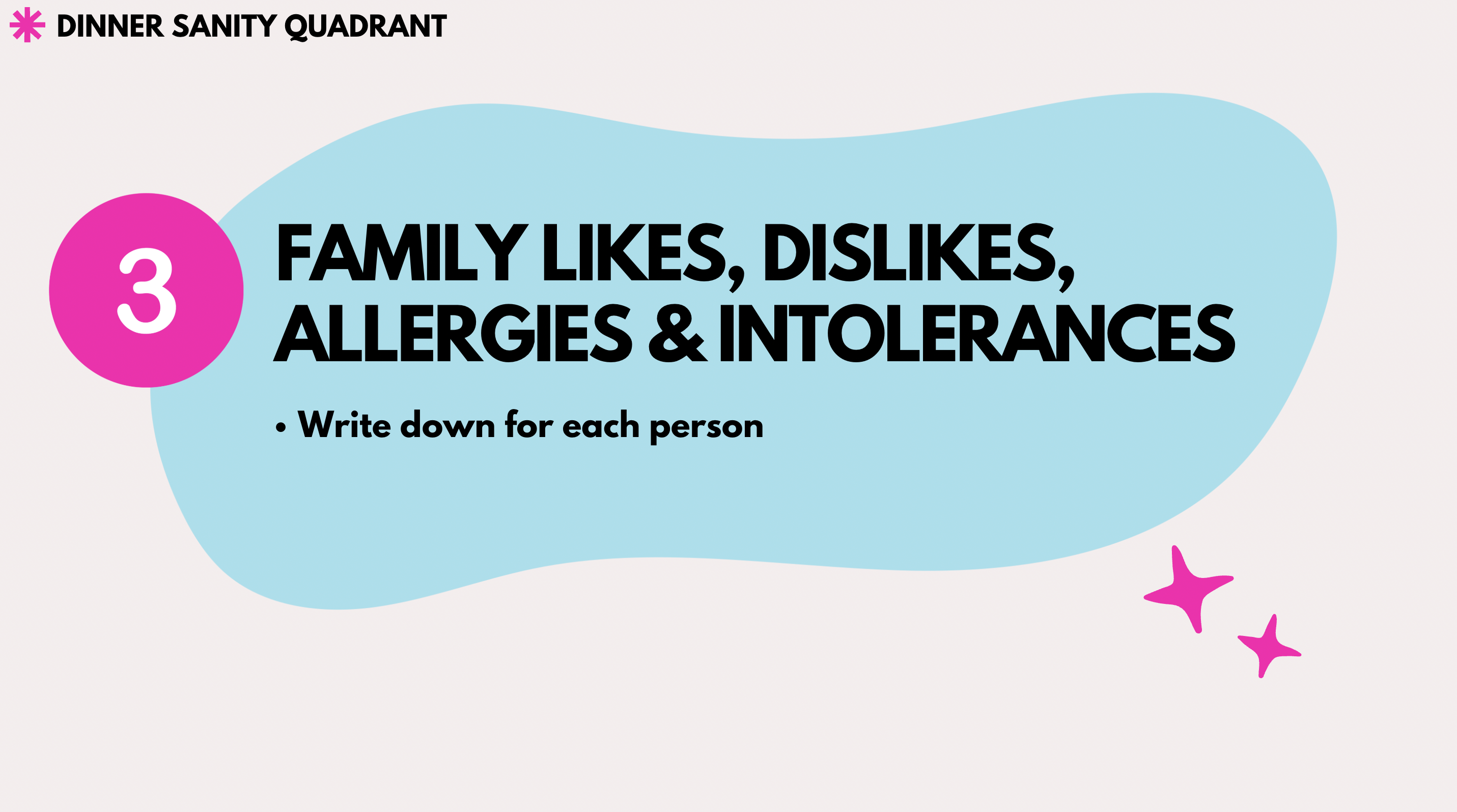
Step 3 - Family Likes & Dislikes
Alright, now let's talk about your people-the characters you're cooking for every night. Dinner isn't just about your energy-it's also about the personalities and preferences at your table.
For each person in your household, jot down:
- Favorite meals (instant wins): These are your safe bets-the meals that will always get eaten without complaint.
- Hard no's (dealbreakers): Things like "won't touch mushrooms," "absolutely not spicy," or "refuses leftovers." These are important to note so you're not banging your head against the wall making meals that never work.
- Allergies or intolerances: Any must-avoid ingredients for health reasons.
👉 Don't overthink this. Just write what you know. Even a quick list of two or three likes and dislikes for each family member is a huge help.
This step is about awareness, not perfection. When you can see everyone's preferences on paper, dinner stops feeling like a guessing game.
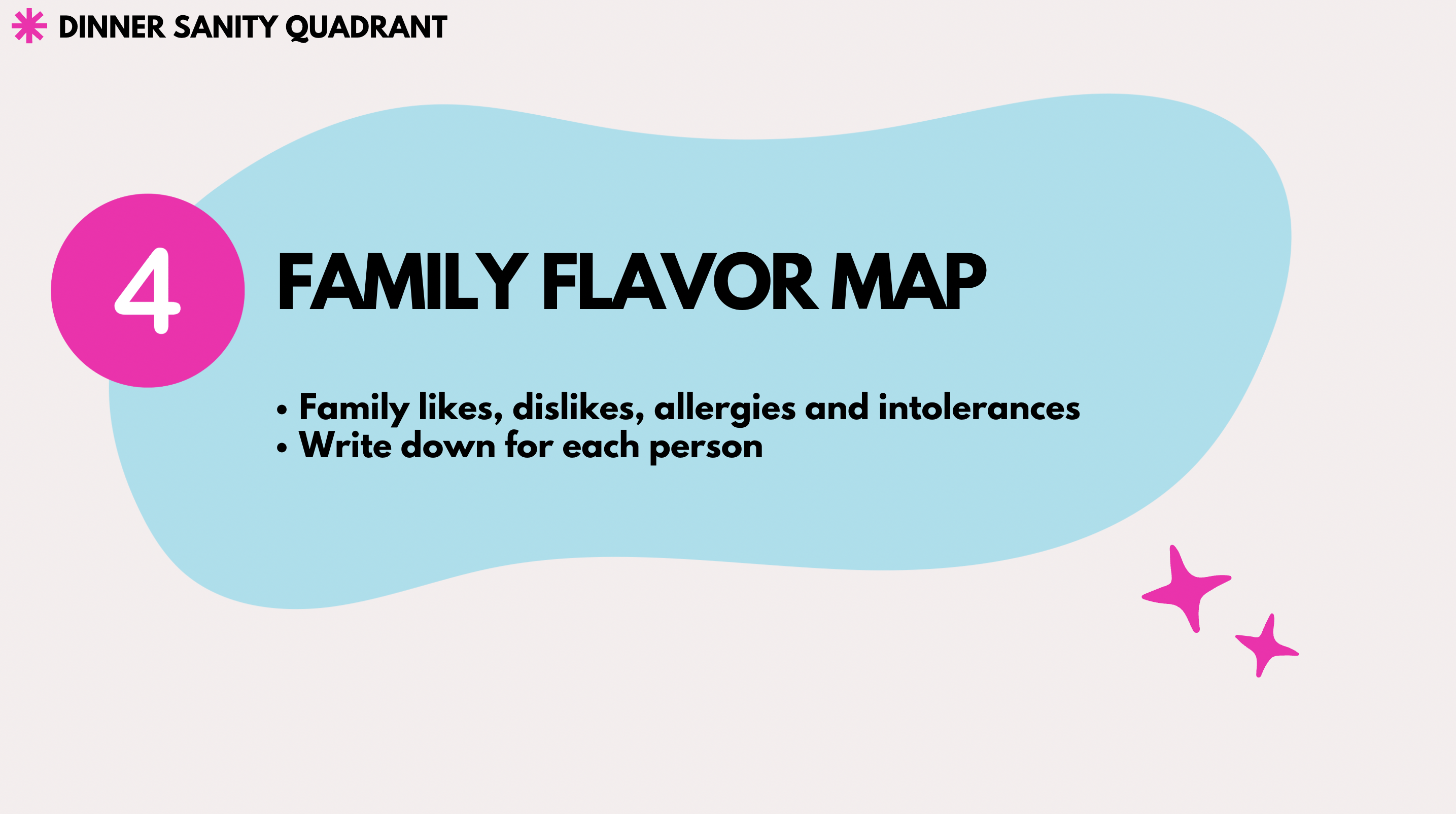
Step 4 - Family Flavor Map
Now let's pull that information together into what I call your Family Flavor Map. Think of it as a cheat sheet for the unique mix of tastes in your household.
Here's a quick example of what one might look like:
- Dad: loves steak, hates pasta
- Kid: loves mac & cheese, won't touch mushrooms
- Mom: loves stir fry, mild spice only
Notice how simple it is? Just a few bullet points per person gives you a clear snapshot of what works-and what doesn't.
👉 What's so great about this method is that most of us have never really paused to do this before. But once you have it written down, it explains so much of the friction at the dinner table. Suddenly you can see why certain meals flop, why others are a hit, and where there's overlap you can build on.
The Family Flavor Map isn't about catering to every whim-it's about understanding the landscape so you can make smarter, easier choices. Knowing what works for your family helps you figure out which meals can stay, which can go, and what new ones might be worth trying.
Take a few minutes and fill out your own Family Flavor Map now. It doesn't have to be pretty-just get it down on paper.
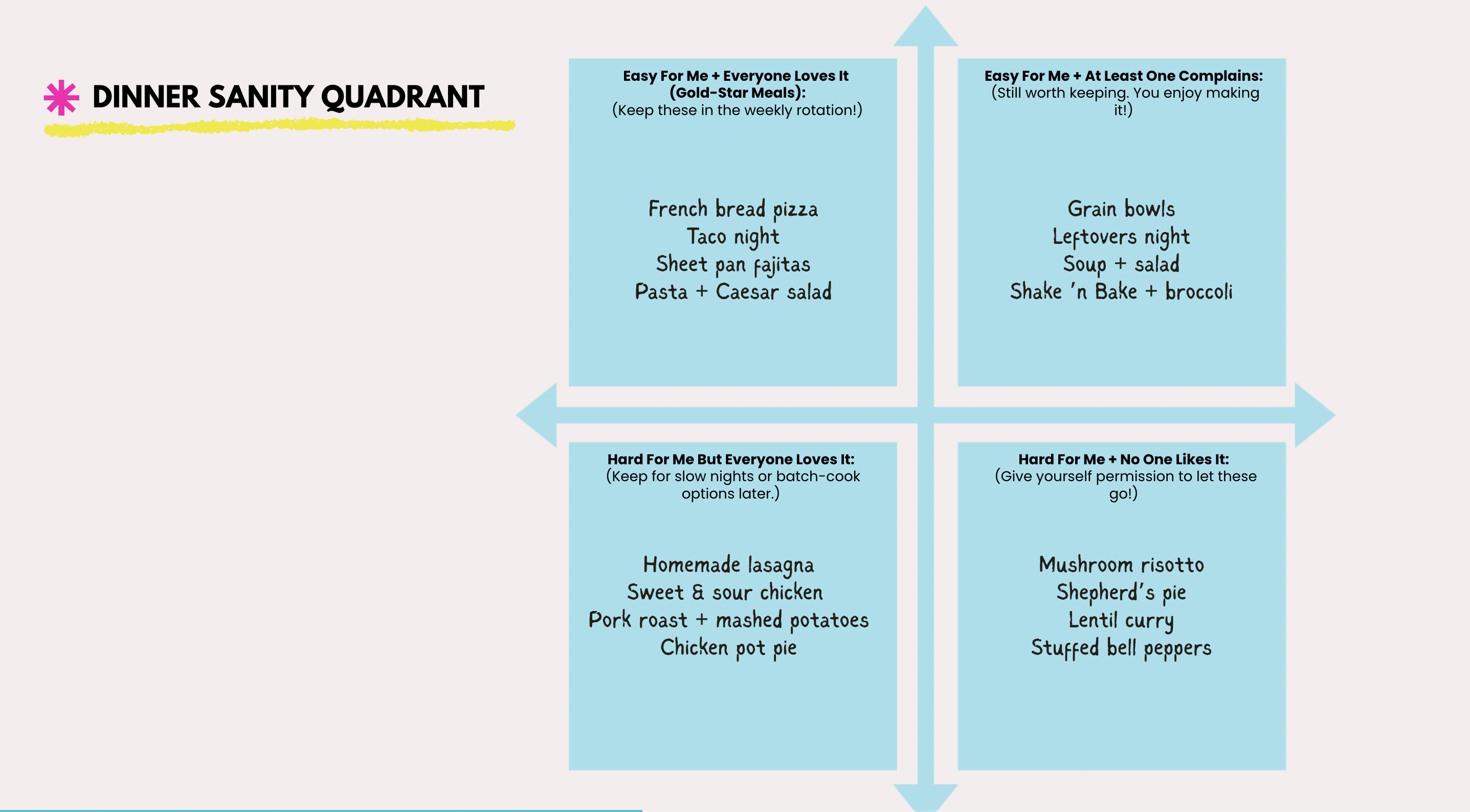
Step 5 - The Dinner Sanity Quadrant
Now let's look at the meals themselves that you've already written down-and how much effort they actually require.
Because not all dinners are created equal:
- Some come together fast and leave you thinking, "Okay, I've got this."
- Others drag on and drain you before you've even chopped the onion.
- Some get eaten without a peep.
- Others turn into a table-side negotiation-or end up in the trash.
So let me introduce you to the Dinner Sanity Quadrant. It's a simple way to sort your current meals using two questions:
- How easy is it for you to make?
- How much does your family actually enjoy it?
Here's how it breaks down:
- Top Left: Easy to Make + Everyone Loves It
These are your gold-star dinners. They come together fast, get eaten with no complaints, and make you feel like, "Okay, I can do this." We're definitely keeping these in your rotation. - Top Right: Easy to Make + Someone Complains
Maybe it's your go-to stir fry, but your kid always picks out the broccoli. You enjoy making it. It's not hard. We're keeping these-for now-and we'll tweak them later. - Bottom Left: Hard to Make + Everyone Loves It
These might be your from-scratch favorites. Maybe your family devours them-but they wipe you out. We're not throwing them away, but we'll save them for nights when you've got more in the tank. - Bottom Right: Hard to Make + No One Likes It
These are the meals you keep trying to make… even though no one eats them and they stress you out. Maybe they looked good online. Maybe they were "supposed to be healthy." If you dread making it and your family dreads eating it-it's time to let it go. No guilt. Let it retire.
👉 Look at the meal list you've already created and start to place each one into the quadrant. Ask yourself:
- Did my family eat it-or pick it apart?
- Was this easy for me?
- Did I enjoy making it?
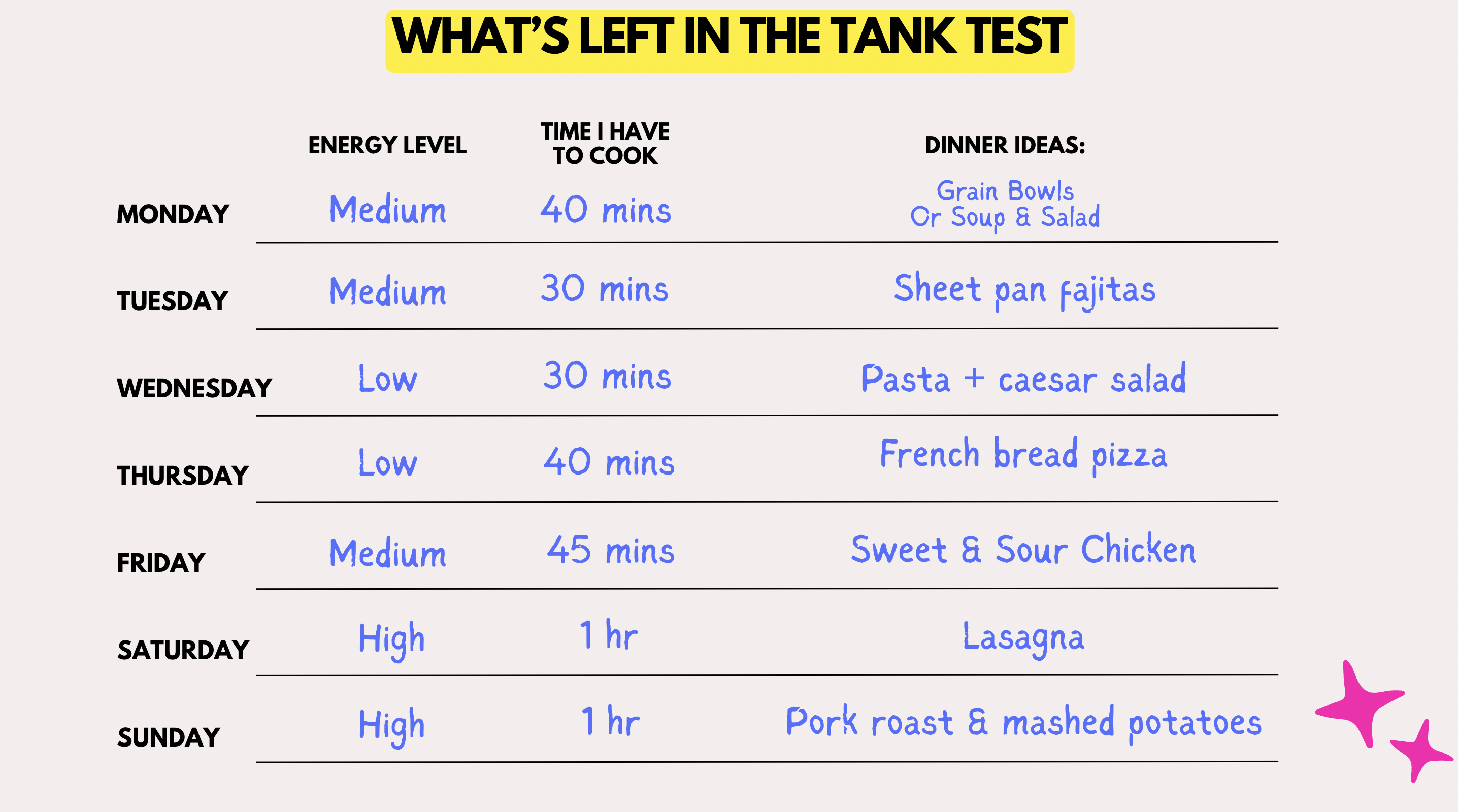
Step 6 - Match Meals to Energy
Now you want to take the dinners you listed in your Dinner Sanity Quadrant, and start pairing them to your actual week. The way you do this is with your What's Left in the Tank Test from Step 2.
Ask yourself:
- Which of these meals feel doable on your lowest-energy nights? → Think: frozen pizza, rotisserie chicken + bagged salad, grilled cheese and soup.
- Which meals could fit on the medium-energy nights? → Think: stir fry, baked pasta, sheet pan chicken (one-pot meals are lifesavers here).
- Are there any nights that always fall apart and need a backup option? → Make a note-we'll cover that next with Grace Nights and Emergency Dinners.
You don't need to fill every day. You're just sketching a rhythm based on what works for you.
👉 Think of this like fitting puzzle pieces together-matching reality with rhythm. Not chasing perfection. Just working with what's already true.
What You've Built So Far
Okay-let's just take a moment to look at what you've actually done so far:
- You mapped out the way you actually cook.
- You made a real-life list of dinners you already default to.
- You took stock of your family's food personalities.
- Then you sorted those meals through the lens of effort and enjoyment...
- …and matched them to your real-life energy levels throughout the week.
👉 That right there? That's the core of your dinner rhythm.
Not a rigid plan. Not a dream version of your life. But a clear, honest picture of what's already working-and how to build on it.
FAQs
That's actually useful information! It means your current rhythm isn't serving you. Start phasing those meals out and replace them with budget-friendly dinners that don't feel boring or stretching leftovers until you find better fits.
This is common! Use your Family Flavor Map to spot "middle ground" meals or create simple sides that let everyone customize. (For tough nights, keep emergency dinners ready.)
Nope. Dinner rhythms are for you, too. If a meal drains you, it belongs in the "retire it" category. There's always a way to find a new recipe that everyone will accept.
Every few months-or anytime your season shifts (back to school, sports, holidays). Your rhythm should flex with real life.
Even the best rhythm can collapse when:
- You forget to defrost the chicken.
- Your kid melts down at 4:30.
- Your brain just flatlines after a long day.
Next Up: The Dinner Rhythm Toolbox
👉 Next up, we'll dive into The Dinner Rhythm Toolbox-your built-in safety nets like Emergency Dinners and Grace Nights. These are the tools that keep dinner afloat on the hardest days 👇👇
Dinner Rhythm Blueprint: Here's Your Roadmap 👇👇
📌 Part 1: Dinner Rhythm Overview
📌 Part 2: What's Left in the Tank Test
📌 Part 3: The Dinner Sanity Quadrant (You Are Here 📌)
📌 Part 4: The Dinner Rhythm Toolbox
📌 Part 5: Finalizing Your Dinner Rhythm
👉 Want the big picture? Start from the beginning on the Dinner Rhythm Blueprint Hub


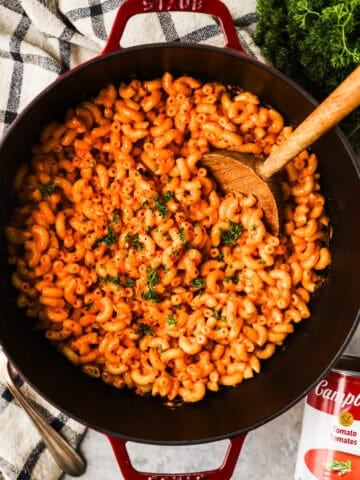

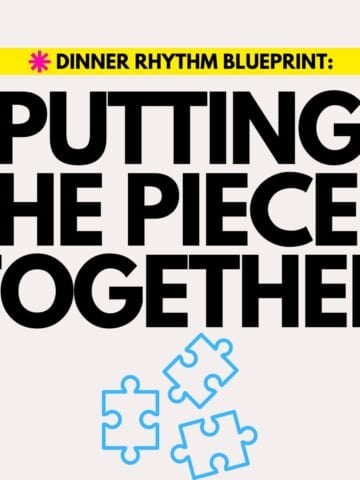
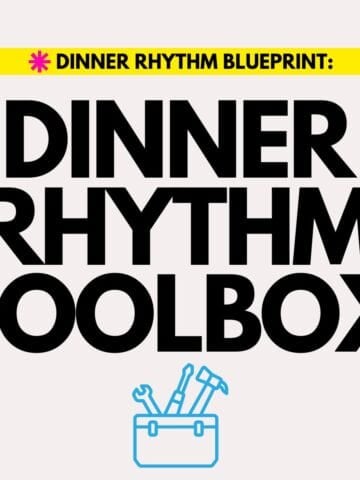
Leave a Reply